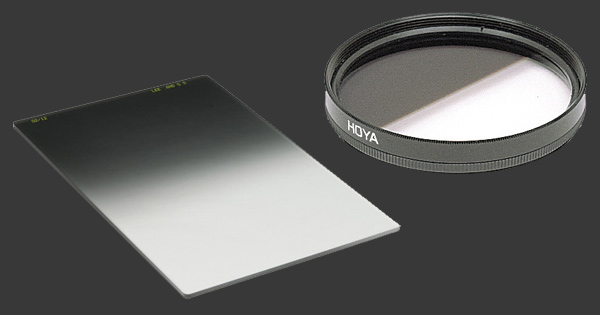Hardware vs Software: Graduated Neutral Density Filters
News
2012.10.30
This is the first of a series of posts comparing hardware and software ways of getting a photographic effect.
During the glory days of film, the Graduated Neutral Density filter was considered an essential part of a landscape photographer's toolbox. Even as photographers take on landscape photography digitally, it remains widely used.
Simply, a Graduated Neutral Density Filter (GND) is a filter which is clear at one end and dark at the other. Between the two levels of transparence, there is a transition which can be hard or soft, depending on the filter. Square GND filters are more common because they can slide to adjust the point of transition but they are much more cumbersome. Round GND filters always transition at the same point but they can be rotated.

There are two ways to simulate a Graduated ND filter by software and they both have different advantages and disadvantages compared to a physical filter. Here is how all three approaches compare:
Hardware Filter
- Pro: Gives you results immediately which you can see while you compose.
- Con: The effect is fixed in gradation and shape. There is always a straight transition between transparency levels. It is also recommended to meter manually since camera meters are not made to accommodate GND filters.
Software Effect
A software effect, such as the one present in Adobe Photoshop Lightroom, processes a single image to make one side darker than the other. It does so by darkening one side of an image and leaving the other untouched.
- Pro: Adjustable in strength, size, shape and direction.
- Con: Cannot recover clipped details. Blown out areas cannot get details back while a hardware filter may prevent over-exposure.
Exposure Fusion / HDR
Exposure fusion is a software algorithm that blends multiple exposures of the same subject to produce an image that holds details from a wider dynamic-range. For a list of exposure-fusion software, read this question at Photo.StackExchange.
HDR is another multi-exposure technique which produces an image which holds a huge dynamic range. This image is impossible to view directly on typical displays and cannot be printed, so it must be tone-mapped into an image of standard dynamic-range. This is more complex than Exposure-Fusion but allows to produce surreal images using different tone-mapping algorithms.
- Pro: Completely adjustable. Can simulate any strength, shape and size of ND filter.
- Con: Anything that moves between exposures can cause problems and requires more work.
- Digital Photography
Please Support Neocamera
All information on Neocamera is provided free of charge yet running this website is a huge endeavor. Purchases made via affiliate links found throughout the site help keep it running and up-to-date. There is no additional cost to you, so please consider buying via these links to our affilates:
If you found any information on this site valuable and did not purchase via our affiliate links, please considering donating via PayPal:
Any amount will be greatly appreaciated. Thank you for your support!
New Cameras & Lenses

Fujifilm Fujinon XF16-55mm F/2.8R LM WR II
Weatherproof
Fujifilm X Mount Zoom
2024-10-24
Fujifilm Fujinon XF500 F/5.6R LM OIS WR
Stabilization & Weatherproof
Fujifilm X Mount Prime Lens
2024-10-24
Fujifilm X-M5
26 Megapixels Mirrorless
Fujifilm X Lens Mount
2024-10-24
Panasonic Lumix S 18-40mm F/4.5-6.3
Weatherproof
Leica L Mount Zoom
2024-10-09
Tamron Di III 90mm F/2.8 VXD Macro
Sony E Mount Prime Lens
2024-09-30
Tamron Di III 90mm F/2.8 VXD Macro
Nikon Z Mount Prime Lens
2024-09-30
Updates
2024.08.07

Eye Protection Tips for Professional Photographers
The four main considerations for professional photographers regarding eyewear.
2024.07.14

Fujifilm X100VI Review
Flagship fixed-lens compact digital camera with a 40 MP sensor and Image-Stabilization, a first for the series. Retro design featuring dual control-dials, plus direct ISO, Shutter-Speed and EC dials. Its hybrid viewfinder can switch between EVF and OVF mode.
2024.05.09

Fujifilm GFX100 II Review
Flagship 102 Megapixels Medium-Format Mirrorless Digital Camera with 8-Stop 5-Axis IBIS, 8 FPS Drive, 8K Video and 400 MP Super-Resolution capture in a weatherproof and freezeproof body with dual control-dials and dual memory-card slots.
2024.04.03

Fujifilm X-T5 Review
Newest Fujifilm flagship boasting a 40 MP APS-C sensor, 5-axis IBIS with 7-stop efficiency, 15 FPS continuous drive, 6.2K Video capture, dual control-dials and dual SDXC UHS-II slots in a sturdy weatherproof and freezeproof body.
2023.11.20

Best Digital Cameras of 2023
Find out which are the Best Digital Cameras of 2023. All the new Mirrorless Digital Cameras from entry-level to high-end professional.
2023.07.10

Fujifilm X-H2 Review
40 Megapixels APS-C Hybrid Mirrorless Digital Camera with 7-stop IBIS. Fastest shutter ever and 8K video capture. Large builtin EVF with 0.8X magnification and 5.8 MP, plus an Eye-Start Sensor. Packed with features and large number of controls in a weatherproof and freezeproof body.
2023.05.07

Sony FE 20-70mm F/4G Review
Review of the unique Sony FE 20-70mm F/4G lens. The optical zoom of this lens spans ultra-wide-angle and medium focal-length coverage, making it one of the most versatile Full-Frame lenses on the market.
2023.01.15

Huion Inspiroy Dial 2 Review
Review of the Huion Inspiroy Dial 2 tablet, a medium sized drawing surface with dual dials and customizable buttons. Connects via USB-C or Bluetooth 5.0 with Windows, Linux and Android support.
2022.12.08

How to Pack for a Photo Trip
Find out how to pack for a travel photography trip, carry your gear safely while meeting airline regulations.
2022.11.13

Best Digital Cameras of 2022
The best digital cameras of 2022. A short list of the most outstanding models in their respective categories. Choose one for yourself or as a gift.
2022.09.21

Pentax DA* 60-250mm F/4 SDM Review
Review of the Pentax DA* 60-250mm F/4 SDM, the constant-aperture telephoto zoom with the highest zoom-ratio on the market.
2022.09.20

Pentax DA* 50-135mm F/2.8 SDM Review
Review of the Pentax DA* 50-135mm F/2.8 SDM, the lightest professional telephoto zoom native to the K-mount.







